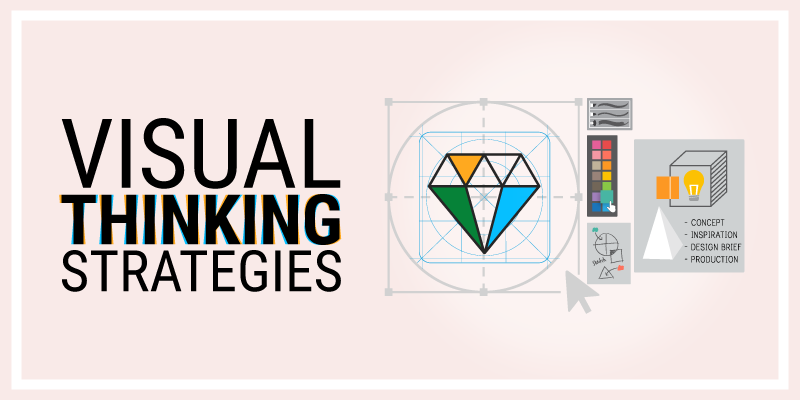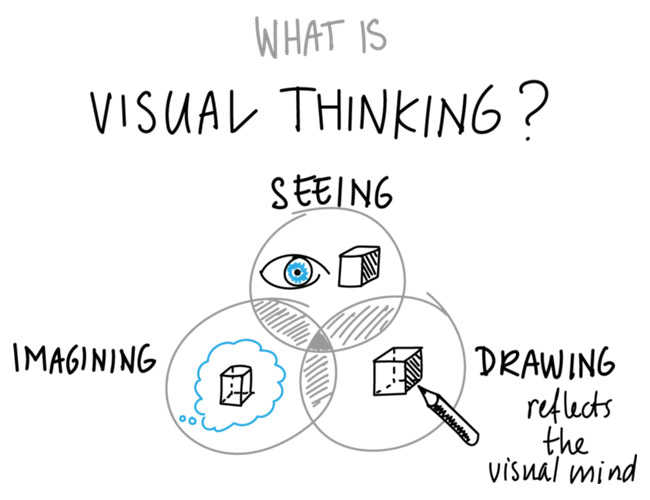Visual Thinking Strategies For Designing Unique Logos For Startups

Featured Image: Freepik.com
As an intermediate designer, one who has passed the beginner stage, made most of the mistakes newbies do, it is time to refine your logo design process starting with the right kind of brainstorming and thinking. Let us take a look at some noteworthy visual thinking strategies to design unique logos for startups from all industries.
But first, I feel it is important to explain what a “unique logo” is because many times you see this phrase paired with logo designs that are cliché and overused. For example, featuring a brand’s logotype with something as plain as Helvetica is not unique when everyone starts doing the same thing. Similarly putting the hackneyed swoosh shape doesn’t allow you to make anything unique, let alone a logo.
So we must first understand a thing or two about customized unique logos.
Unique Logos Under Inspection
According to several dictionaries, the word “unique” is a descriptive term used to describe something that has no equal and it is distinct. This means that a unique logo should not resemble a graphic work that already exists and that it is something no one has seen before.
When creating unique logo designs, you cannot copy designs. Plagiarism is not allowed and inspiration should be taken wisely. If the client requests you to make a replica of a vector graphic that someone else designed and marketed before you, then you must inform the client of the repercussions of this activity. Let them know about the details regarding copyrights, trademarks, and derivative designs so that they know what a unique logo stands for.
Well, you’re a designer and you should have the capacity to make original ideas and execute a sui generis logo for every client.
So how do you come up with concepts for unique logos each time you start a contest?
Visual Thinking Strategies For Unique Logos
The journey to designing a unique brand identity starts with the way you think about and through the researching, planning, and accomplishing levels of design.
It is important, as designers, to understand that “design is a process” and those who are haphazardly making logos are not doing justice to this design. It involves creativity, no doubt, but the creative spark in designers is directed and controlled by the visual thinking strategies and the graphic design process they chose.
Visual thinking strategies allow designers to practice their innovative and creative solutions in a defined manner that uses mechanisms and techniques catered to assist the smooth flow of a given design contest or project.
In the design thinking process, visual thinking strategies help improve critical thinking in designers whereby they question their selections and keep refining their answers for a better outcome. These strategies aim to assist designers in deeper learning and truly grasp the client’s creative brief, the process of the design project, and how they will approach the requirement with a set budget.
By utilizing visual thinking strategies, you can achieve the following goals and more:
- Sharpen your observation skills
- Improve your communication style
- Boost your cognition and reasoning
- Optimize your learning and research
- Balance client needs and your creativity
- Develop your design choices and skills
- Manage project time and resources
- Stimulate creative thinking to solve problems

Image Source: Medium.com/ Kim S van den Berg
List Of Top Visual Thinking Strategies
Now that you have a quick idea about what a unique logo is and how the design process as well as visual thinking strategies can help you create a custom and professional logo design, let us finally look at these strategies.
Go Do Visual Sightseeing
When working on a design contest, explore images that (directly or indirectly) relate to the topic or the subject matter you will work on. Don’t limit yourself to the online world, and get out of the house to your nearest library and museum, or walk on the streets to capture pictures that connect with a client’s graphic project. When you’re done collecting, observing, and analyzing then gather only the inspirations that will help you with the project.
By images, I don’t mean vectors or illustrations you can easily trace, but raster images or natural objects. Note the minute details like how shadows and highlights are cast, how a geometric or organic object is embellished with elements, and how things are staged or fit in a composition.
When you have your shortlisted images, observe them closely, and see how the items have been placed with other things, and how they’ve been colored and textured. This exercise will help designers in creating illustrations for logos from scratch rather than rely on a stock website because they will, by then, get the hang of how things look and function.
This strategy will open your mind to endless possibilities and promote visual awareness and also develop designers’ visual literacy abilities.
“Visual literacy is a social and cognitive process. It is the process of generating meanings in transaction with multimodal ensembles including written text, visual images, and design elements, from a variety of perspectives to meet the requirements of particular social contexts.” – The Value and Practice of Visual Thinking Strategies by Heidi Williams, Claudia Burns, Peggy Daisey, Ph.D.

In design, visual literacy helps designers use graphic elements and apply logo design principles in a way that is meaningful, pleasing, and entertaining.
Light Your Listening Habit
We stop learning the moment we stop listening. Now, this is something you need to do even when you are not working on a design project because listening is a habit and you need to build it up gradually.
To execute an artwork visually, you need to listen because visualization is enhanced when you use other senses than just the sense of sight.
When we stop listening, thinking we know it all and we know the best, we shut the window of opportunity to learn more about design itself and also about the specific client’s work.
When you are not busy with a project, listen to what designers and non-designers say about designing. Also, make sure to hear out clients you have or have not worked with – learn their stories, recommendations, and even complaints not just about the result but about the entire process.
If you’re in a design contest, with or without the luxury of time, listen to the clients. When working with a team, hear out what each member has to say.
It will also be helpful to listen what customers think about a particular and how it should look like.
Dare To Connect The Dots
Know that no matter which design thinking process you choose to work with, you have to make the links between all the stages. For example, you can’t plan something different to what you execute in the end. This process is not unlinked, it is an evolution that blossoms you from seed to flower.
Also, you need to make sure that your planning stage isn’t in conflict with the description of the project in the client’s brief. For example, a client asks you to build them a modern image and you plan out a vintage look for them.
So make sure that you’re constantly connecting the dots to complete the bigger picture.
Blend In Or Break Out
Senior Vice President at Elizabeth Christian Public Relations, David Wyatt shared a handy strategy with us, one that involved “competitive audit” in the “research and development phases of branding”. He further explains that designers should “gather the brands of all relevant competitors and aspirational companies and put them up physically or digitally to see what themes emerge.”

Wyatt also said, “This is illuminating because themes and outliers emerge, especially as you start identifying brand options. If you want to be seen shoulder-to-shoulder with bigger competitors you might want to choose a brand direction in line with the larger context. But if your strategy is to stand out from the others in your field area, then visually you will want to break out of the pack.” Working with or without themes is only possible when you know what theme is followed by which industry.
Embrace The Questioning Quest
If you’re into philosophy, you may be aware of the famous Socratic Method that involves participants asking questions until a better definition of just about anything comes to light. This strategy aims to clarify misunderstandings, probe reasoning, and assumptions, refine perspectives and viewpoints, and investigate consequences and implications.
If you have no idea about what Socrates, the renowned philosopher said about asking questions then know that as a designer, one of the visual thinking strategies is to keep asking relevant questions that aid you in the design process. Examples include:
- How does this symbol relate to the brand’s image?
- How can we verify that a vector graphic truly explains the brand’s vision?
- What’ll be the effect of being able to understand this logo and not being able to?
- What kind of generalizations can be drawn from this design?
- What are the strengths and weak points of this design?
Questions like such drill the design process and help a single designer or a design team continuously analyze, evaluate, and test their ideas and concepts.
To Tread The Path Of Trends, Or Not?
Now, this strategy involves a dilemma: to follow trends or not. If in your project you have decided to use a particular design trend then first explore all the latest logo design trends and then read the truth about trends to decide if you will use a trend or not.
So what is the truth and why does it matter when using visual thinking strategies?
When you are designing a logo, you are thinking visually. This means that the outcome will be visual so you need to imagine the appearance of the logo design throughout the process of designing a brand logo.
Now you need to understand that visual taste changes with time. What people like and what the industry accepts keeps shifting. For example, in the 1880s Art Nouveau designs took rise but later as the world began to think about minimal visuals, constructivism played an imminent role in the design industry of branding.
With this in mind, it is necessary to research trends, know their pros and cons, and decide whether or not any single one of them will match the brand you are working on.
Also, to make unique logos, it will be best to create a corporate logo design that doesn’t follow a trend that has been beaten to the ground. Keep thinking, though out the process, about whether to use a trend or not and how can you do so to make something no one has made before.
Take A Step Back
Wait, what? Take a step back, yes. Emilie Vicchio, Brand and Creative at Heal & Boost Inc. shares one of her interesting visual thinking strategies. Vicchio recommends, “When starting a company, a business will usually start with the logo before they fully flesh out the brand. Try not to do it this way, and work backward instead. Take some pressure off the logo, and take a step back, and think of your whole brand identity before you think about your logo.”

She goes on to explain, “This is NOT an excuse for poor execution or dismissing design theory. It just takes the pressure off the designer and business owner to find the perfect visual cue for their company. It allows them to understand how the logo supports their brand.”
She used the same strategy for her brand and decided to “start to build the visual entity as a whole” than to only focus on how the logo will look separately. I like this tip because with this “agile thinking strategy” designers and business owners can design a logo that is true to the brand vision and brand image rather than being something generic or fit-all-business type.
Conclusion
Visual thinking strategies don’t always mean how to select a particular color palette or which typeface will look better in a wordmark logo or study theories like the Gestalt theory for logo designing.
Know that these strategies also include techniques that guide you to create an attractive and memorable logo graphic. For example, listening and questioning may not be visual methods but they lead a designer into thinking visually and effectively for something that will be visual i.e. you will be able to see or feel (if the logo is in braille).
Well, good luck! Guess you need it. Designing a logo is always a challenge but if you have the right tools and tricks up your sleeves then the game is yours.
Do you know more visual thinking strategies? Share one with us. If it’ awesome, I’ll include it in this post.
Sources:
Gavin Ambrose and Pau Harris (2009) Basics Design 08: Design Thinking. AVA Publishing.
Visual Thinking Strategies: Understanding the Basics (2009) Copyright Visual Understanding in Education, Inc.
Audio Visual Logos
Cloud Computing Logos
Software Development Logos
IT Firm Logos
Business Logos
Conference Logos
Consulting Firm Logos


